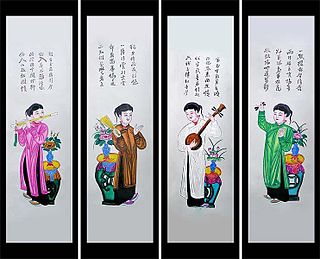
Vietnamese cuisine encompasses the foods and beverages originated from Vietnam. Meals feature a combination of five fundamental tastes : sweet, salty, bitter, sour, and spicy. The distinctive nature of each dish reflects one or more elements, which are also based around a five-pronged philosophy. Vietnamese recipes use ingredients like lemongrass, ginger, mint, Vietnamese mint, long coriander, Saigon cinnamon, bird's eye chili, lime, and Thai basil leaves. Traditional Vietnamese cooking has often been characterised as using fresh ingredients, not using much dairy or oil, having interesting textures, and making use of herbs and vegetables. The cuisine is also low in sugar and is almost always naturally gluten-free, as many of the dishes are rice-based instead of wheat-based, made with rice noodles, rice papers and rice flour.

Phở or pho is a Vietnamese soup dish consisting of broth, rice noodles, herbs, and meat – usually beef, and sometimes chicken. Phở is a popular food in Vietnam where it is served in households, street-stalls, and restaurants country-wide. Residents of the city of Nam Định were the first to create Vietnamese traditional phở. It is considered Vietnam's national dish.

Rice vermicelli is a thin form of noodle. It is sometimes referred to as "rice noodles" or "rice sticks", but should not be confused with cellophane noodles, a different Asian type of vermicelli made from mung bean starch or rice starch rather than rice grains themselves.

Bánh xèo is a crispy, stuffed rice pancake popular in Vietnam. The name refers to the sound a thin layer of rice batter makes when it is poured into the hot skillet. It is a savoury fried pancake made of rice flour, water, and turmeric powder. It can also be called a Vietnamese crêpe. Some common stuffings include pork, prawns, diced green onion, mung bean, and bean sprouts. Bánh xèo is often served with sides. Usually, some commonly added ingredients include leafy greens like lettuces or perilla leaves, other herbs as flavor enhancers like mint leaves and Thai basil, cucumbers, and pickled vegetables, usually carrots and radishes. Lastly, its dipping sauce is nước chấm. Elements of each side and sauce add to the fresh-tasting fried Bánh Xèo.

Mì Quảng, literally "Quảng noodles", is a Vietnamese noodle dish that originated in Quảng Nam Province in central Vietnam. It is one of the region's most popular and well-recognized food items, and is served on various occasions, such as at family parties, death anniversaries, and Tết. It is a common food item in Ðà Nẵng and the surrounding regions, where it is eaten at any time of day.

Bún bò Huế or bún bò is a Vietnamese rice noodle (bún) dish with sliced beef (bò), chả lụa, and sometimes pork knuckles. The dish originates from Huế, a city in central Vietnam associated with the cooking style of the former royal court. The dish has a mix of spicy, salty, and savory flavors. The predominant flavors are those of lemongrass and shrimp paste. Compared to phở or bún riêu, the noodles are thicker and cylindrical.

Cơm tấm is a Vietnamese dish made from rice with fractured rice grains. Tấm refers to the broken rice grains, while cơm refers to cooked rice. Although there are varied names like cơm tấm Sài Gòn, particularly for Saigon, the main ingredients remain the same for most cases.

Vietnamese cuisine includes many types of noodles. They come in different colors and textures and can be served wet or dry, hot or cold, and fresh (tươi), dried (khô), or fried.

Cầu Giấy is an urban district of Hanoi, the capital city of Vietnam. It is located roughly to the west of urban Hanoi. Cầu Giấy has a unique urban landscape, with new urban developments interlacing old historical artisan villages. The most well-known of them is a cluster of Dịch Vọng villages with its popular cốm dessert.

Bún chả is a Vietnamese dish of grilled pork and noodles, which is thought to have originated from Hanoi, Vietnam. Bún chả is served with grilled fatty pork (chả) over a plate of white rice noodles (bún) and herbs with a side dish of dipping sauce. The dish was described in 1959 by Vietnamese food writer Vu Bang (1913–1984), who described Hanoi as a town "transfixed by bún chả." Hanoi's first bún chả restaurant was on Gia Ngư, Hoàn Kiếm District, in Hanoi's Old Quarter.

Bún mắm is a fermented thick Vietnamese vermicelli soup sometimes called "Vietnamese gumbo."

Bún thịt nướng, which originated from Southern Vietnam, is a popular Vietnamese dish of cold rice vermicelli topped with grilled pork, fresh herbs like basil and mint, fresh salad, giá, and chả giò. The dish is dressed in nước mam fish sauce. The dish is topped with roasted peanuts, Vietnamese pickled carrots, nem nướng̣ or grilled prawns. Bún thịt nướng is popular in all regions of Vietnam, alongside Hanoi's bún chả.

Nem nướng is Vietnamese grilled pork sausage or grilled meatballs, and a popular Vietnamese food item, sometimes served as an individual appetizer or snack, or served with rice noodles or rice as a main course. Nem nướng is a specialty of Khánh Hòa Province . Nem nướng is a rustic dish, originating from Ninh Hoa, a northern district of Khanh Hoa province, about 30 km from the coastal city.
Dim Tu Tac, founded in 2015, is a Cantonese cuisine and dim sum restaurant chain in Ho Chi Minh City, Vietnam. 'Dim tu tac' means "anything you want" or "anything is possible" in Cantonese language. The name also expresses the restaurant's mission to help food lovers explore the Cantonese gourmet world through a combination of innovative cooking techniques and the using of ingredients from many different culinary cultures.

The COVID-19 pandemic in Vietnam has resulted in 11,624,000 confirmed cases of COVID-19 and 43,206 deaths. The number of confirmed cases is the highest total in Southeast Asia, and the 13th highest in the world. Hanoi is the most affected locale with 1,649,654 confirmed cases and 1,238 deaths, followed by Ho Chi Minh City with 628,736 cases and 20,476 deaths; however, the Vietnamese Ministry of Health has estimated that the real number of cases may be four to five times higher.

Hanoi Kitchen is a Vietnamese restaurant in Portland, Oregon.

Stateside is a Vietnamese fusion restaurant in Seattle, in the U.S. state of Washington.















